Menu
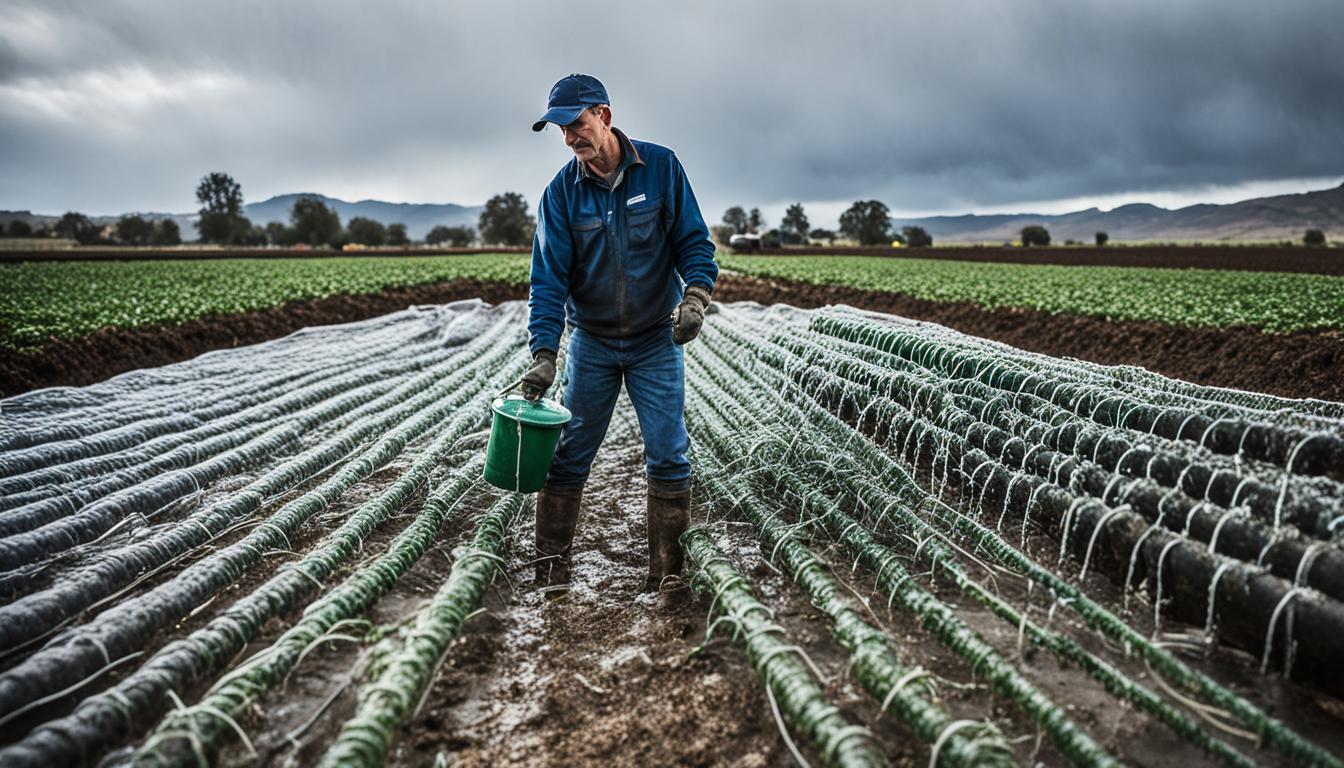
Did you know drought and riverine flooding cause about $2 billion in losses each year? This happens in the West and Midwest’s agriculture sector. These figures point out how crucial it is to manage water on farms better. In places like California, water is key for growing a variety of crops. Since the Sierra Nevada snowpack might drop by half in the next 80 years, good water management is vital.
Farmers need to plan for emergencies and use water wisely every day. They should have strategies that fit their area’s special needs. This means making a set of tools to handle water issues in farming. With these tools, farms can deal with too little or too much water.
Managing water well on farms is key. The amount of water available affects how well crops grow and if the farm can last long term. Keeping the balance right is crucial. It means using just enough water when it’s needed to keep plants healthy and grow well, and not more to save water.
Using water well is vital for farms to run smoothly and stay green for the future. Having enough water lets crops and animals thrive. Smart use of water helps crops grow strong, saves water, and makes the farm live longer. Farmers should be careful to give just the water plants need when they need it. This helps get the best out of the land and saves water too.
Farms deal with a lot, especially weather changes and new rain patterns. The weather can be hard to predict sometimes, but farms must stay ready. Also, as more people need water, it gets harder for farms to use enough. New tools like the California Irrigation Management Information System (CIMIS) help farmers save more water. This system gives farmers data to use water wisely, even in tough times, and keep farming strong.
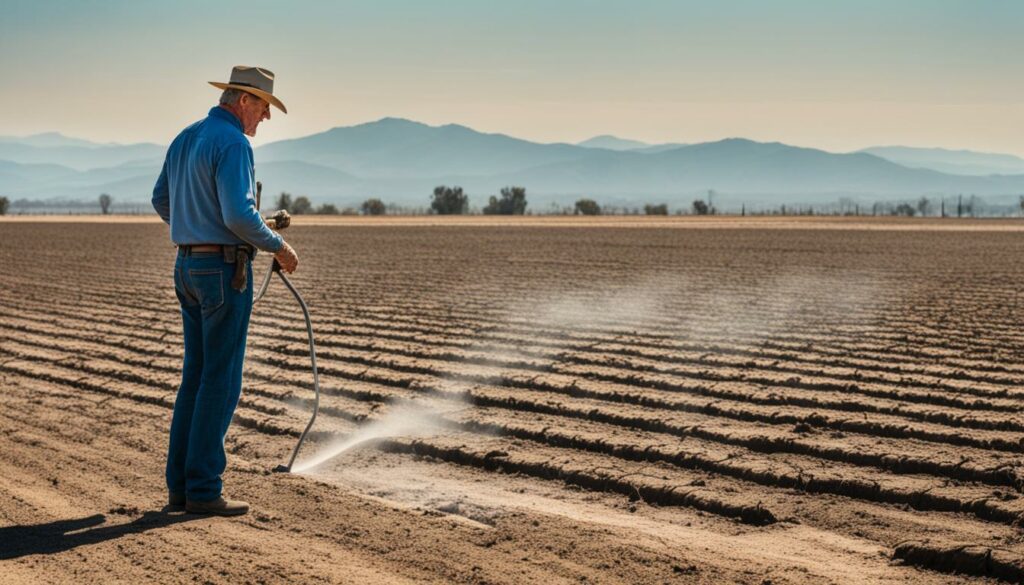
Climate change is having a big effect on managing water and how we farm all over the world. In New South Wales (NSW), farming is a key part of the economy, adding up to $17.5 billion. This shows how vital water is for keeping this economic engine running.
The Murray-Darling Basin, an important farming area in NSW, is feeling the heat of climate change. It provides about one-third of Australia’s food. Although it’s vital, about 13% of NSW’s greenhouse gas emissions come from farming. This shows how connected farming is to climate changes.
Changes in the weather are making it hard for crops, plantations, livestock, and fibres to grow. Hotter weather and less rain mean water for farming is becoming scarce. This leads to more droughts, worse fire weather, and stressed animals.
Looking ahead, more carbon dioxide in the air could change how well crops grow. This might mean less food can be grown. Also, rain might become less common in the winter and spring, affecting crop water sources. When it does rain, it’s often too much, causing problems like soil erosion and crop damage.
Because of these issues, smart water management is essential. The Climate Smart Agriculture Toolkit by Farmers for Climate Action helps in reducing farm emissions and adapting to climate change. With less water for farms, new ways of managing water are crucial to keep farming going and ensure NSW’s food future.
In summary, the effects of climate change on water and farming are serious. We need to find smart ways to use less water in farming. This is key to keeping our economy strong and food plentiful.
Modern farming demands smart use of water. Farmers are learning techniques to save water while growing more crops. These methods help the earth stay green for the future.
Using the right irrigation system is key to saving water. Drip irrigation and sprinkler irrigation are great examples. They can use up to 80% less water than the old ways. This is because they put water right where it’s needed, near the plant roots. This stops water from evaporating or running off.
The AGWAM team is working hard to improve water use on farms. They focus on states like Indiana, Illinois, and others. By helping farmers reduce nitrates and save water, they protect the soil and water quality. This work supports farming that can last for a long time.
Mulching keeps the soil moist and healthy. It covers the soil with materials. This cuts down on water loss from evaporation. Mulching also adds good stuff to the soil. This makes it better for plants and holds onto water more.
Other methods like not ploughing everything, planting special crops, and using compost help too. For example, moving animals around when grazing can make the land soak up more water. And it makes the land ready to deal with less rain during dry times. This work is helped by organisations like the Nevada Irrigation District. They give water to a lot of farms.
| Technique | Benefit |
|---|---|
| Drip Irrigation | Saves up to 80% more water |
| Sprinkler Irrigation | Minimises evaporation and runoff |
| Mulching | Reduces moisture loss and improves soil health |
| Conservation Tillage | Increases water absorption |
| Rotational Grazing | Decreases runoff, enhances drought resistance |
In the end, combining various irrigation techniques and using mulch makes a big difference. It helps keep the soil healthy and holds onto water better. This is important for making sure we can keep farming for a long time.
Farmers need reliable water all year, even when weather changes. They must watch over and use water well to keep farming sustainable.

Farmers have many choices for storing water. They can use reservoirs, tanks, ponds, or even hide water under the ground.
Reservoirs hold lots of water but lose much to evaporation. Things like heat, humidity, and wind affect this. Making the water area smaller helps save more water.
Tanks give farmers more control over their water. They can put tanks where they’re needed for crops or animals. Tanks also cut the flood risk and keep water available in dry times. Adding copper and zinc mix, barley straw, or bleach stops algae in tanks.
Reticulated water systems can boost water quality for animals. Thinking about animals’ daily water needs and room to grow helps plan well.
Using solar or air well pumps and smart monitoring makes water use better. These tools are good at saving money and water, important for keeping farms going.
Here’s a look at how much water different systems save for farming:
| Delivery System | Return Rate |
|---|---|
| Overhead | 90% |
| Capillary | 48% |
| Drip | 45% |
Having reservoirs of a certain size and reusing water is smart farming. It helps the environment and is cost-effective.
Modern farm irrigation methods are key for agriculture’s future. The precision irrigation system is one standout. It lets water go straight to plant roots, using water better and wasting less. It’s time to switch from old ways to these new ones, like using pressurised irrigation and lining channels with concrete. We also need to automate canals.
These new techniques may cost a lot at first. But they save a lot of water and help crops grow better. They make a good economic and environmental change. For example, by using a system that checks if crops need water using technology. This system helps farm management work better, saving resources and keeping crops healthy.
Stanford University has come up with a new tool for irrigation that’s very fast. It measures evapotranspiration, the rate at which plants lose water, very quickly. This tool is great because it makes drip irrigation work better. Drip irrigation saves a lot of water, which is super important in places like arid California.
Then, there’s research that looks at the colours and water levels in sunflowers. This research tells us about the plants’ health and how much water they have. It’s important to talk about successful examples to see how these new methods help. Also, looking at how to keep soil healthy to hold water better is a big research area.
| Technique | Benefits | Challenges |
|---|---|---|
| Precision Irrigation | Efficient water use, enhanced crop yield | High initial investment |
| Automatic Irrigation Scheduling | Real-time decision making, water conservation | Technological dependency |
| Drip Irrigation | Targeted water delivery, reduced wastage | Maintenance and monitoring required |
Field tests are the next big step. We need to see if all these new tools and methods really work in real farms. This testing is crucial for making water use in agriculture sustainable and strong.
Using water wisely in farming is key for both our crops and our future. The right methods can keep our water sources going strong. This way, we boost what we grow without drying up our water.
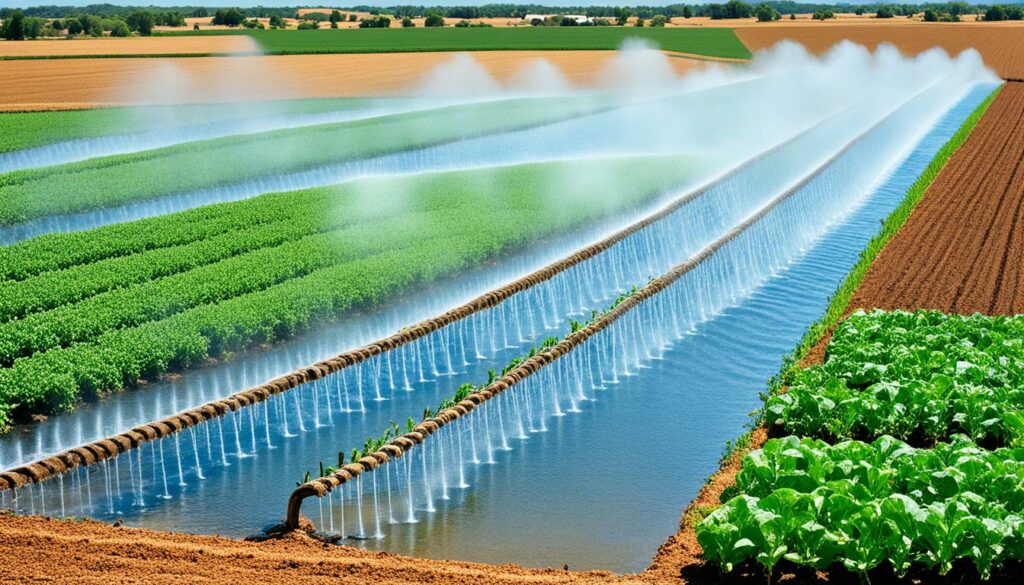
Water is a big part of farming, making up around 80% of water use globally. In the U.S., farming uses 85% of all water. This shows why managing water well is vital. Technologies like drip irrigation, though they cost more at first, can use up to 80% less water. Using compost and mulch also helps soil hold water better and stops it from escaping into the air.
Many stories show how effective good water use can be. For instance, the Nevada Irrigation District gives out almost all its water for farming. It helps over 5,600 places and looks after more than 32,000 acres. Techniques such as leaving part of crops on the ground can stop soil washing away and help save water. Also, using techniques like dry farming for some crops means they can rely less on constant watering.
By 2024, at least 40 states in America could be short of water. Stories like these show how to use less water and work better with what we have. They also help keep our water pure and available for everyone, making a greener world for all.
Technology is changing how we manage water on farms. It provides tools for better use of resources. This leads to more efficient water use and increased productivity.
IoT sensors mark a huge step in water management on farms. They track soil, air, plant, and weather data. This information helps farmers make smart choices about watering crops.
OpenET, for example, uses satellites to track evapotranspiration. This means farmers can water exactly when and where their crops need it. Plus, the Groundwater Accounting Platform checks water resources in real time to protect groundwater.
LPWANs are great for saving energy when managing water. They have a long reach and use little power. This setup is essential for covering large farmlands with IoT devices without draining batteries. IoT gateways also step in to keep systems safe and process data ahead of sending it out.
Apps for managing water on the move have become very important. They connect wirelessly and let farmers control water use in real time. This tech makes decisions quicker and more accurate.
Then there’s big data software. It sorts through a lot of information to make reports. These reports help farmers plan better and use data smarter. And with Decision Support Systems (DSS), they get easy-to-understand graphs and helpful comparisons. This makes water management even more efficient.
| Technology | Applications | Benefits |
|---|---|---|
| IoT Sensors | Soil moisture, air humidity, plant water usage data collection | Improved irrigation precision |
| OpenET | Satellite-based evapotranspiration data | Accurate irrigation scheduling |
| Groundwater Accounting Platform | Real-time monitoring of water resources | Sustainable groundwater management |
| LPWAN | Low power, wide area connectivity | Extended reach, energy savings |
| Mobile Applications | Real-time data using GPS and date-time parameters | Enhanced decision-making |
| Big Data Software | Data processing and analytical report generation | Informed strategic decisions |
| Decision Support Systems (DSS) | Graphical data representation, software integrations | Data-driven agricultural practices |
Government policies are key in setting up strong agricultural policies and water management. They bring together national and state efforts. This is to improve how we save water by giving out money and support. The Emergency Conservation Program (ECP) is very important. It gives a lot of help for emergency conservation works.
Federal and state plans push forward water saving in farming. They set up the tools and help farmers need to use water well. For instance:
Having funds for water saving in farming is vital. Many programmes offer money help:
| Program | Purpose | Funding Details |
|---|---|---|
| Emergency Conservation Program (ECP) | Fix damages and fences broken by natural disasters. | It offers a 75% cost-share, or up to 90% for some farmers. |
| Livestock Indemnity Program (LIP) | It helps with the cost of livestock dying in bad conditions. | The help changes by loss and situation. |
| Dairy Indemnity Payment Program (DIPP) | It supports dairy farmers if they can’t sell their milk due to pollution. | Funding is based on the milk’s value. |
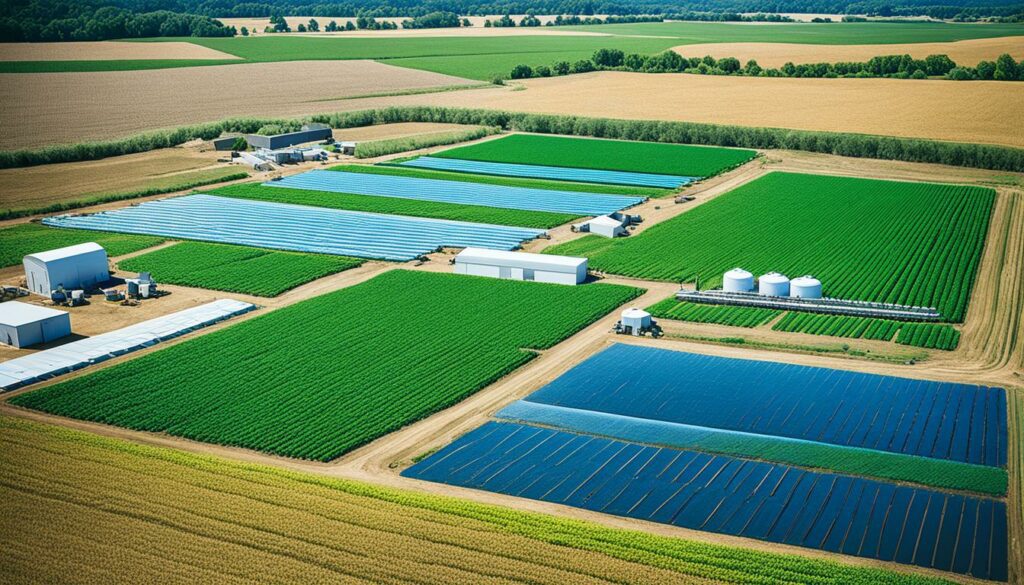
Farmers and ranchers should talk to their local FSA office. There, they can find out about ECP and other national schemes for good water use. Using these tools, farmers can plan for a future where they have enough water. They also bounce back from hard times better.
Working together in water management is key for farmers to tackle the complex issue of water sustainability. This includes farmers, researchers, tech providers, and policymakers pooling their knowledge and resources. These partnerships offer the best path for achieving long-term goals.
Precision irrigation methods are a prime example of how teaming up brings results. They’ve let farmers use less water but still grow crops well. Plus, joint efforts by manufacturing and environmental groups have made manufacturing greener. This helps cut water pollution and save resources.
Energy companies play a significant role too. They partner with local people to lessen their effect on water and help the community flourish. Their collaborative efforts boost wise water use, lessen pollution, and improve how risks are thought about and handled. Such work has not only benefited water projects but has also helped create jobs, improve economies, and make life better for many.
The Sierra Nevada’s snowpack is expected to drop significantly by 2100. This shows the urgent need for teamwork in water management. Places like the Yakima Basin and the Southwest are also facing water challenges. In these areas, plans to handle changes in the climate and natural disasters need group efforts.
In the West and Midwest of the US, farms face big losses from droughts and floods each year. To deal with these emergencies, well-organised, group-based approaches are vital. This work falls in line with worldwide projects like the EU’s push to revive rivers and wetlands. The goal is to help these areas by 2030.
The EU’s Water4All scheme is set to make a big impact thanks to serious money and focus. A huge €400-450 million budget, with €126 million from the EU, shows their strong commitment. This is welcomed as the water crisis threatens 2.2 billion people by 2030.
Nearly half the world might face water stress by 2030. With billions still having no clean water or sanitation, acting is crucial. Strong partnerships and ongoing team efforts are crucial to achieve the water and sanitation goal by 2030.
| Partnership Efforts | Impact |
|---|---|
| Precision Irrigation Techniques | Reduced water usage while maintaining crop yields |
| Eco-Friendly Manufacturing Processes | Lower water pollution and resource consumption |
| Community Engagement by Energy Companies | Mitigated operational impact on water resources |
| Comprehensive Water Management Strategies | Promoted responsible water use and enhanced risk assessment |
| Community Water Management Initiatives | Enhanced job creation, economic development, and quality of life |
Community-based approaches are key to managing water sustainably. They focus on water use in farming. These methods get local people involved, making sure their needs and what they know are part of using water well.
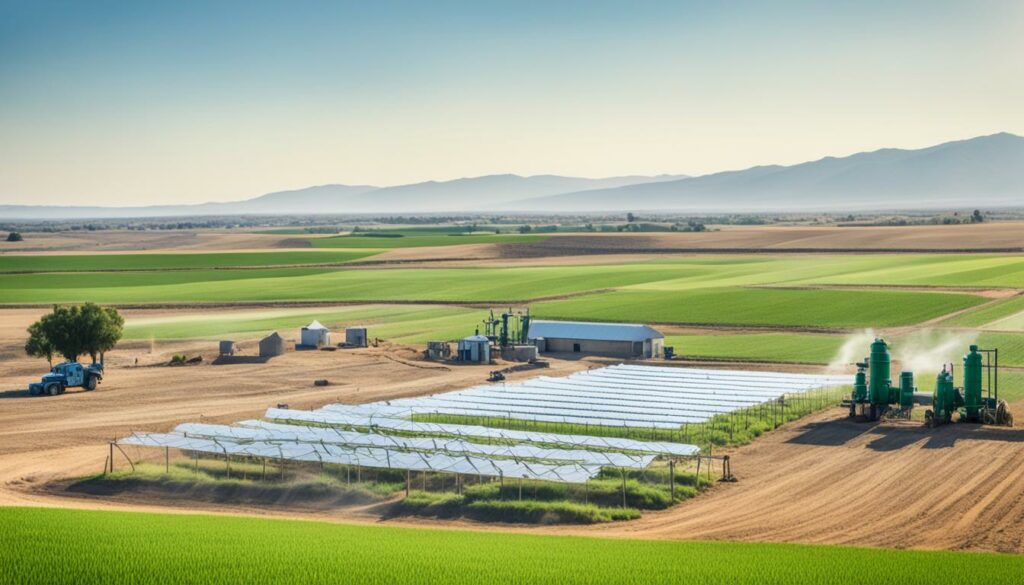
It’s vital that local people are part of managing water. They bring their own wisdom, which helps deal with not having enough water. In places like refugee camps, where water is really needed, every bit of managing it makes a difference.
Local help also means things like watering crops and feeding animals are done right. This way, the water doesn’t run out too quickly, and bad water sources are not used. Plus, it prevents things like water pumps from breaking, which happened in Darfur because of poor planning.
Working together helps more than just in sharing water. It makes communities stronger in using water wisely. This helps when facing problems like not enough rain, a big issue because of climate change.
This teamwork is also crucial for everyone’s needs in hard times. Making things like bricks and selling water in camps with lots of people shows how important community action is. It means water can keep flowing for everyone safely.
| Key Areas | Details |
|---|---|
| Daily Groundwater Abstraction | 330m³ per day per km² |
| Population Density in IDP Camps | Exceeding 22,000 people per km² |
| Water Demand Activities | Irrigation, Home Gardens, Livestock Watering |
| Groundwater Depletion Risks | Mechanical Failure, Accessing Unprotected Sources |
| Community Based Solutions | Safeguarding Water Resources, Resilience Against Climate Change |
Getting communities hands-on in water farming works well. It solves water shortages and strengthens farming. This makes for stronger, healthier places to live.
Risk assessment and planning are key for effective water management on farms. Disasters like tropical storms, floods, and droughts cause major damage. They put lives, homes, and jobs at risk. It’s vital to do a full agricultural water risk assessment. The number of people facing these risks may go up by 400 million in the next 30 years. This is about 20% of the world’s population, showing why farm water management planning is urgent.
Getting ready for climate water issues needs careful planning. In England, the UK’s flood risk assessment shows river and sea flooding risks to 2.4 million properties. The cost of this flooding can be over USD 1.2 billion a year. These figures highlight the importance of making long-term plans for farm water security.
Recent studies show that most people are working on ways to assess water risks. They are also mapping out where these risks are highest. This mapping helps farmers know where they need to focus on preventing problems.
The FDA’s Agricultural Water Assessment Builder is another key resource. It helps farms meet the rules on agricultural water. You just answer questions about your farm’s water systems and the environment. This info isn’t kept by the FDA. You can save or print it to help with managing water better on your farm.
It’s a good idea to check water sources at the start of the growing season. Then, check them a few more times during the season. This, along with keeping an eye on water systems, is very important. Drip irrigation is seen as a good way to use water wisely.
Testing for E. coli in water is very important. Areas where water touches crops need special attention. Labs should test water for E. coli. They follow strict rules for collecting samples. Keeping detailed water test records is crucial for keeping farms safe.
Risk assessments work best when many groups work together. This whole approach, with everyone and every part of the government involved, focuses on lowering risks. This also helps farmers protect their crops from the changing climate and water issues.
Adapting to drought and flood conditions is key for farming to stay strong and productive. We’ll look at smart ways to deal with drought in farming and how to manage floods on farms. These are crucial for lessening the bad effects of extreme weather.
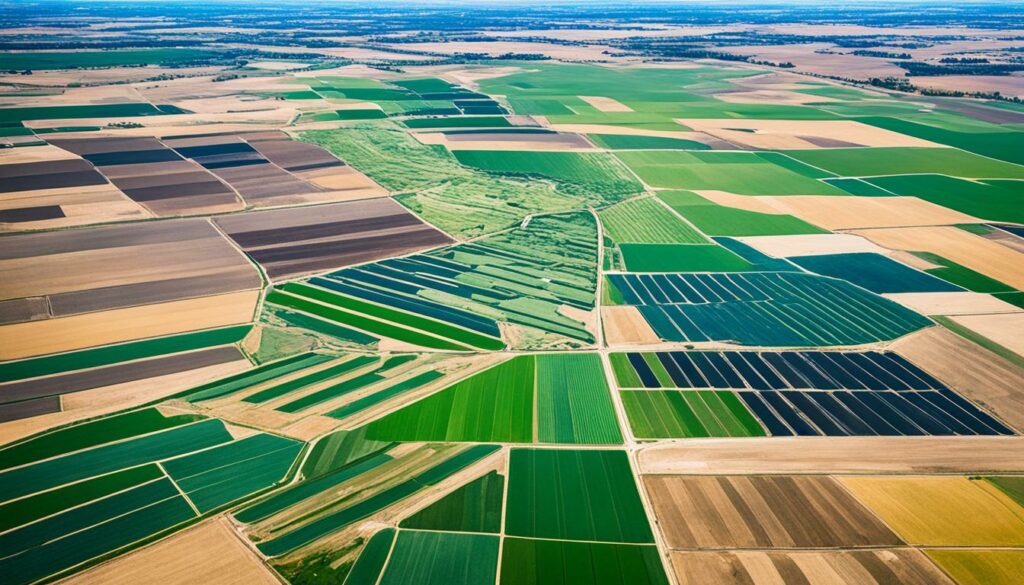
Droughts are tough, but there are ways to fight back in agriculture. Methods like mulching and no-till farming keep the soil moist, cutting water loss. Using crops that can survive with less water is also vital. In California’s Sierra Nevada, snow levels may drop up to 65% by 2100. So, these strategies are more important than ever.
To tackle the more frequent floods, it’s crucial to have good flood management on farms. Techniques like raising field beds and better drainage help avoid flood harm. In the U.S., floods have damaged corn crops worth $10 billion from 1989-2016. Better ways to deal with floodwater can save crops and keep farms running. These steps prepare farms for both floods and droughts.
| Region | Impact | Strategy |
|---|---|---|
| California | 65% snowpack decline | Soil moisture conservation, drought-tolerant crop varieties |
| Midwest | $2 billion annual losses | Improved drainage, elevated field beds |
| Pacific Northwest | Drop in crop yields | Improved irrigation, soil conservation practices |
| Southwest | Increased reliance on groundwater | Groundwater management, drought-resistant crops |
| Kansas | Decline in water resources | Water-efficient irrigation, drought planning |
By applying these focused drought strategies in agriculture and strong flood management on farms, we can make agriculture more resilient to climate change. This safeguards our crops, incomes, and ways of life.
It’s vital for farms to have emergency water management plans ready. This helps protect the farm during water crises. In Minnesota, farmers should get ready for various emergencies. This includes tornadoes, floods, heavy snow, and fires.
Farmers must put together a detailed emergency contact list. This list should have phone numbers for vets, county emergency services, the Extension office, insurance agents, and other key people.
It’s also important to keep insurance updated for emergency protection. Have action plans for staying put and leaving. Include the best ways out for animals and where to meet up after.
Teaching farmworkers First Aid means they can help in medical crises. They can assist with things like heart attacks, allergies, and injuries.
It’s smart to check gas levels near manure stores to avoid gas issues. Having plans for small spaces and the right gear, like harnesses for entrapments, is key. This can help save lives.
Crisis management for water on farms involves keeping a stock of medicines and supplies. Update what you have often. Make sure everyone knows how to use important farm tools. This makes the farm ready for any surprise.
The below table shows important parts of getting ready for water emergencies:
| Emergency Preparation Area | Action Steps |
|---|---|
| Contact List | Get numbers for vet, emergency services, the Extension office, insurance |
| Insurance Review | Check if you’re covered for different emergencies |
| Action Plans | Create plans for staying put and leaving |
| First Aid Training | Teach your team how to help in medical crises |
| Hazard Monitoring | Keep an eye on gas levels near manure storage |
| Equipment Utilisation | Use safety equipment for small space emergencies |
Give jobs to staff and hand out emergency maps. This speeds up help in an emergency. Update your emergency plans on social media to keep them current. Working with local authorities and first responders is smart. They give advice to make your plans better. Keep checking and improving your emergency water management plans to stay strong in any crisis.
Ensuring there’s enough water on farms is critical. With climate change, droughts are getting worse. The need for smart water use is key now more than ever. For example, some places may face serious droughts every 2 to 3 years. Others see this only once every 5 to 6 years. So, we need different plans for different areas.
In 2012, the USDA said over two-thirds of U.S. counties were hit by drought. This was the worst drought in 50 years. Over a century, places like South Dakota and Indiana saw severe drought many times. This shows long-term water management challenges. We must manage water in a way that lasts, as shown by the 2014 California act.
Dealing with water shortages in emergencies can help a lot. It cuts water use by up to 35% and boosts crop yields by about 20%. It also saves a lot of money on water and irrigation costs. Places using these plans decrease crop loss from water problems by half. This proves being smart about water can make farms stronger.
By managing water better and being ready to adapt and innovate, we can protect our agriculture. The future of farming depends on how we handle water issues now. As we face more challenges from the changing climate, focusing on smart water use is crucial. This will help our farms not just survive but thrive.
Implementing efficient irrigation systems is important. So is using on-farm water storage. Data-driven technologies can help make smart decisions. It’s also key to save water and plan for emergencies.
Managing water is key for farms to grow crops. It ensures farms can use water wisely and stay productive. Good management also helps deal with changing weather and not enough water.
Farms face problems like unpredictable weather and more demand for water. They must find new ways to use water well and last a long time. This is vital for the future of farming.
Climate change makes water harder to predict and use. It causes more harsh weather. Farmers need to change how they manage water to keep growing crops well and protect the land.
Conserving water is critical. Techniques include using systems that don’t waste water and covering soil with something to keep water in. These simple changes help save water and grow food better.
Farms store water in many ways like in tanks and underground. These water reserves help farms stay strong even when there’s not much rain. They are like an emergency supply.
Good storage ideas are systems that use the weather forecast to set water levels. Also, having big water tanks helps. Storing water under the ground is another clever method. These show how to be smart with water on farms.
New ways to water crops include systems that feed plants directly. Sensors and flying drones can check if crops need more water. These ideas save water and help farming last for the future.
Using water well includes smart farming and planting things that don’t need much water. This way, farms can be strong for a long time without using too much water.
Technology like OpenET uses space data to watch water use. The Groundwater Accounting Platform helps too. These digital tools make using water better and based on facts.
The government helps farmers save water by offering money and helping with new systems. This support encourages farmers to use water wisely.
Working together with scientists, tech companies, and the government can make water use better. Everyone brings ideas to the table, making farming smarter and safer for water.
Community plans listen to what people know about water. This makes the plans work better for everyone, making it easier to use water well and keep the area’s farms healthy.
Planning for too much or too little water is smart. It helps farms keep growing, no matter the weather. By looking ahead, they can be ready for anything.
In dry times, keeping water in the soil and choosing tough plants helps. For floods, making fields higher and good drainage protects the land and crops.
An emergency water plan needs quick steps to take, ways to talk with others, and clear instructions to follow. It helps everyone be ready and know what to do in tough times.